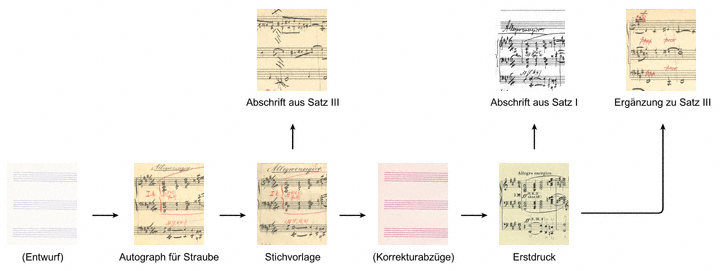I. Sonata in F sharp minor op. 33
for organ
- I. Phantasie
- II. Intermezzo
- III. Passacaglia
Herrn Prof. A.W. Gottschalg grossherz. sächs. Hoforganisten in verehrungsvoller Dankbarkeit gewidmet
- -
- -
- -
1.
| Reger-Werkausgabe | Bd. I/2: Phantasien und Fugen, Variationen, Sonaten, Suiten I, S. 54–74. |
| Herausgeber | Alexander Becker, Christopher Grafschmidt, Stefan König, Stefanie Steiner. |
| Verlag | Carus-Verlag, Stuttgart; Verlagsnummer: CV 52.802. |
| Erscheinungsdatum | Februar 2011. |
| Notensatz | Carus-Verlag, Stuttgart. |
| Copyright | 2011 by Carus-Verlag, Stuttgart and Max-Reger-Institut, Karlsruhe – CV 52.802. Vervielfältigungen jeglicher Art sind gesetzlich verboten. / Any unauthorized reproduction is prohibited by law. Alle Rechte vorbehalten. / All rights reserved. |
| ISMN | M-007-09485-0. |
| ISBN | 978-3-89948-141-9. |
1. Composition
The 1st Sonata in F sharp minor op. 33, begun in February 1899, is the only organ work from the Weiden period where Reger sent the Erstschrift (first copy) to Karl Straube before preparing the engraver’s copy (see Reger’s working methods und Manuscripts for Karl Straube). The manuscript was exchanged between composer and interpreter and contains comments by both Reger and Straube, some of which were adopted in the engraver’s copy prepared subsequently. As the correspondence between the two from this period has not survived,1 it remains unclear whether a more extended artistic discussion took place at the same time, and which alterations can be attributed to possible suggestions made by Straube in letters. While the Erstschrift is undated, the engraver’s copy contains the date of completion in autograph “Weiden, 3 March, 1899”.
In the opening movement, which is shaped as a free fantasia, there is only one single suggestion from Straube in the Erstschrift,2 which nevertheless Reger did not adopt. In comparison, the second movement shows more alterations which can be traced back to Straube’s advice. For example, Straube’s comment (“very forced!”) gave the impetus for a pasted over passage on p. 8, where Reger replaced bars 7–8 with a new version. For a few other reworked passages which Reger himself entered in the Straube autograph in pencil, an influence by Straube cannot be proven. These include both the subsequent renaming of the third movement from “Ciacona” to “Passacaglia”3 as well as an extensive alteration of bars 75 to 88 in the Passacaglia: “I have completely rewritten the two variations in brackets!”, Reger noted in the Erstschrift in the lower margin of pages 20 and 21, after he had newly composed this section when writing out the engraver’s copy. The altered bars are included as a loose copy in the Straube manuscript.
On 8 April 1899 Reger informed the organist Arthur Egidi in a letter: “A new sonata (F sharp minor) for organ is finished. […] Where this sonata will be published, I do not yet know; I’ll first let it sit for a while.” (Letter) Whether this should be interpreted as an indication of possible artistic doubts about the work, or whether it is a reference to the uncertain publication situation4 cannot be clarified with certainty.
2. Publication
In summer 1899 Reger sent op. 33 together with the Cinq Pièces pittoresques op. 34 to Aibl-Verlag; he signed the copyright agreement and the confirmation of the receipt of fees for both works on 6 July 1899. Although Reger told the dedicatee Alexander Wilhelm Gottschalg about the imminent publication on 3 October (see letter), he was only able to send the sonata which had “just been published” to Georg Göhler on 21 December and to draw his attention to printing mistakes in the publication (postcard).
The first performance of the work had already been given by Karl Straube, using the Erstschrift, on 14 June 1899, and this contains, in addition to the comments listed above and others, many entries relating to practical aspects of performance such as indications for pedalling, phrasing slurs and cautionary accidentals. Later, Straube received from Reger two further sheets with five passacaglia variations composed later, which he was able to include shortly before the end of the third movement in order to prepare for the final climax; Reger did not include this addition in the published version.
3.
Translation by Elizabeth Robinson.
1. Reception
At present, there are no records of performances in Reger's time.
1. Stemma

2. Quellenbewertung
Der Edition liegt als Leitquelle der Erstdruck zugrunde. Als weitere Quellen wurden Regers autographe Stichvorlage sowie die Erstschrift herangezogen, welche Reger bereits während der Komposition Karl Straube zur Korrektur zukommen ließ (siehe Entstehung) und ihm später schenkte. Straube trug in die Erstschrift Änderungsvorschläge ein, denen Reger bei der Ausarbeitung der Stichvorlage teilweise folgte.
In den Takten 75 bis 88 der Passacaglia weicht die Erstschrift von den entsprechenden Abschnitten in Stichvorlage und Erstdruck grundlegend ab, da Reger diese Takte für die Druckfassung neu komponierte. Die Erstfassung dieser Takte (Erstschrift) ist in edierter Form auf der DVD Bd. I/2 wiedergegeben. Ob die Änderung auf einen Vorschlag Straubes zurückgeht, ist nicht mit Sicherheit zu entscheiden, da die betreffenden Variationen in der Erstschrift lediglich markiert sind und der Briefwechsel zwischen Reger und Straube aus der Entstehungszeit der Sonate nicht erhalten ist. Auf die genannten Einzeichnungen dürfte sich Regers Anmerkung beziehen: “Die beiden eingeklammerten Variationen habe ich total anders gemacht!”
Nach Erscheinen des Erstdrucks verfasste Reger für Karl Straube zudem fünf weitere Passacaglia-Variationen, die er jedoch nicht in Druck gab (Ergänzung zu Satz III). Auch diese nachkomponierten Variationen sind auf der DVD Bd. I/2 ediert und können dort ausgedruckt werden. Regers eigenhändige Abschrift der ersten Seite des Erstdrucks ist für die Edition nicht von Bedeutung.
3. Sources
Object reference
Max Reger: I. Sonata in F sharp minor op. 33, in: Reger-Werkausgabe, www.reger-werkausgabe.de/mri_work_00034.html, version 3.1.0-rc3, 20th December 2024.
Information
This is an object entry from the RWA encyclopaedia. Links and references to other objects within the encyclopaedia are currently not all active. These will be successively activated.